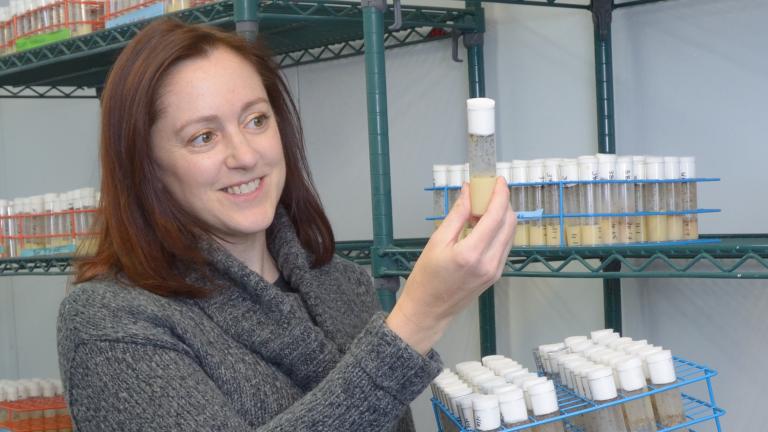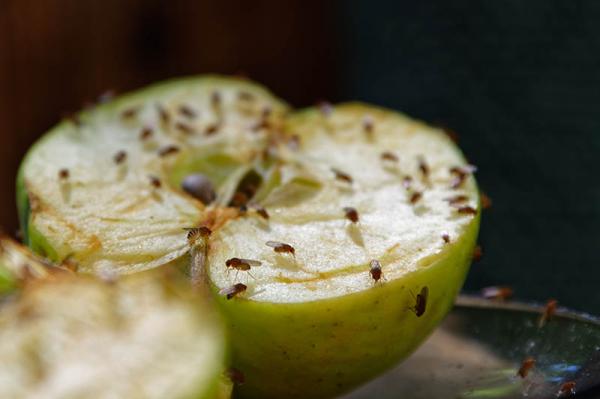From Fruit Fly Genes to Sweet Dreams
IRP’s Susan Harbison Unravels the Genetics of Sleep Disorders
IRP senior investigator Susan Harbison is learning about sleep by examining and manipulating the genes of fruit flies.
Comedian George Carlin used to call sleep “a bizarre activity.” In his act, he observed, “For the next several hours, while the sun is gone, I’m going to become unconscious, temporarily losing command over everything I know and understand. When the sun comes up, I’ll resume my life.”
Every year on March 15, the celebration of World Sleep Day reminds us that sleep remains a baffling biological mystery. What happens when we sleep, why we need it, and why it varies so much between individuals are still unclear despite the best efforts of many scientists. That enduring enigma is what has driven IRP senior investigator Susan Harbison, Ph.D., to investigate the biological basis and genetics of sleep.
“I like studying sleep because it’s linked to underlying physiological processes, but also because I’m just really curious as to why we spend about a third of our lives unconscious,” she says.
Dr. Harbison is decoding the secrets of sleep using a surprising model: Drosophila melanogaster, otherwise known as the common fruit fly. While these tiny creatures appear alert and busy when buzzing around our kitchens and trash bins, they do periodically settle into a quiet state that is analogous to mammalian sleep. And like humans, there are natural variations in sleep patterns between individual flies. Dr. Harbison and her IRP colleagues are identifying the genes that contribute to these differences in the hopes they’ll shed light on human sleep issues.
Fruit flies, it turns out, behave much like we do when it comes to sleep. They’re up during the day and ‘sleep,’ — entering a dormant state — at night. The longer they’ve been sleeping, the longer it takes to rouse them, and just like us, if they don’t get enough rest, they’ll try to make it up by sleeping longer when they can.

Dr. Susan Harbison holds a vial filled with the tiny fruit flies her lab uses in its experiments.
Dr. Harbison’s lab just finished several studies on sleep duration in fruit flies. In one, her team selectively bred flies to be extreme long or short sleepers. Long sleepers slept for about 11 hours per night, whereas short sleepers slept only for a couple hours. The study revealed that the two groups of flies differed in the activity of certain genes as well as how those genes interacted with each other through regulatory signals.1
“It would be fine if we were looking at one gene, but we’ve got 17,000 of them active in a fruit fly,” Dr. Harbison says, “so it’s a challenge when we chart the data to literally connect the dots and see which genes are related to sleep and which interactions between genes are relevant.”
For comparison, they performed a similar study of sleep duration in mice, which are nocturnal. In this case, they used the gene editing technology known as CRISPR/Cas9 to remove a gene called Fzd1. Compared to their genetically normal counterparts, the mice lacking Fzd1 slept more during the day and took fewer naps at night.2
“We found all these differences in mice that had this gene deleted, and that’s really interesting because we originally found the analogous candidate gene in flies,” Dr. Harbison says, which suggests the gene has similar functions across multiple species.
Dr. Harbison’s team has also found several genes that appear to influence when flies sleep and are most active, possibly by affecting their ‘circadian rhythms,’ the daily cycles of the body that determine when we feel tired or hungry, among other things.3 Similar genetic variations may affect sleep patterns in humans, so learning about them could eventually lead to interventions for people whose health or daily functioning is affected by over- or under-sleeping. People who work the night shift are particularly vulnerable to such issues, since working at night disrupts the body’s natural circadian rhythms, which normally drive us to be active during the day and sleep at night.

Dr. Harbison’s research may eventually help lead to interventions for people whose risk of health problems is raised by working the night shift.
“It’s being increasingly recognized that there’s a relationship between shift work and an increase in health problems like heart disease and mental health issues,” Dr. Harbison says. “The way circadian timing interfaces with our sleep patterns is also mimicked in flies. Basically, we’ve found there’s a lot of genetic variability to this irregularity. We’re always happy to find genetic variability in a trait because it means we can map it to the genome.”
Addressing lack of sleep and other sleep disorders is an important public health goal. One in three adults in the U.S. reports not getting enough sleep every night and nearly 40 percent of us drift off when we shouldn’t at least once a month. And for those of us who get less sleep than we need — whether due to stress, sickness, shift work, or sleep disorders — the health consequences are significant. Research has shown that lack of sleep can contribute to a host of conditions like heart disease, stroke, dementia, and depression, as well as an increased risk of accidents and loss of productivity at work.
“I think anybody who has gone without sleep can appreciate its importance,” Dr. Harbison says. “The more irregular your sleep patterns, the greater the risk.”
Subscribe to our weekly newsletter to stay up-to-date on the latest breakthroughs in the NIH Intramural Research Program.
References:
[1] Souto-Maior C, Serrano Negron YL, Harbison ST. Nonlinear expression patterns and multiple shifts in gene network interactions underlie robust phenotypic change in Drosophila melanogaster selected for night sleep duration. PLoS Comput Biol. 2023;19(8):e1011389. doi: 10.1371/journal.pcbi.1011389.
[2] Gessner NR, Peiravi M, Zhang F, Yimam S, Springer D, Harbison ST. A conserved role for frizzled in sleep architecture. Sleep Adv. 2023 Nov 28;4(1):zpad045. doi: 10.1093/sleepadvances/zpad045.
[3] Kumar S, Tunc I, Tansey TR, Pirooznia M, Harbison ST. Identification of Genes Contributing to a Long Circadian Period in Drosophila melanogaster. J Biol Rhythms. 2021;36(3). doi: 10.1177/0748730420975946.
Related Blog Posts
This page was last updated on Friday, March 15, 2024


